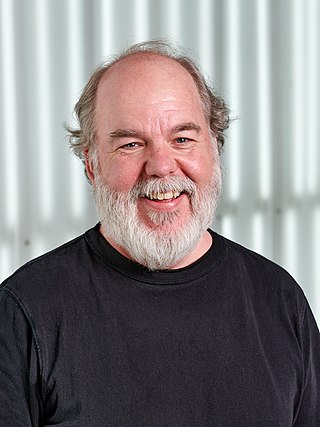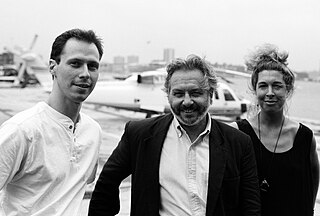Related Research Articles
The Computer Animation Production System (CAPS) was a proprietary collection of software, scanning camera systems, servers, networked computer workstations, and custom desks developed by The Walt Disney Company and Pixar in the late 1980s. Although outmoded by the mid-2000s, it succeeded in reducing labor costs for ink and paint and post-production processes of traditionally animated feature films produced by Walt Disney Animation Studios. It also provided an entirely new palette of digital tools to the filmmakers.
Pacific Data Images (PDI) was an American computer animation production company based in Redwood City, California, that was bought by DreamWorks SKG in 2000. It was renamed PDI/DreamWorks and was owned by DreamWorks Animation.
Wavefront Technologies was a computer graphics company that developed and sold animation software used in Hollywood motion pictures and other industries. It was founded in 1984, in Santa Barbara, California, by Bill Kovacs, Larry Barels, Mark Sylvester. They started the company to produce computer graphics for movies and television commercials, and to market their own software, as there were no off-the-shelf computer animation tools available at the time. In 1995, Wavefront Technologies was acquired by Silicon Graphics, and merged with Alias Research to form Alias|Wavefront.
The Electronic Visualization Laboratory (EVL) is an interdisciplinary research lab and graduate studies program at the University of Illinois at Chicago, bringing together faculty, students and staff primarily from the Art and Computer Science departments of UIC. The primary areas of research are in computer graphics, visualization, virtual and augmented reality, advanced networking, and media art. Graduates of EVL either earn a Masters or Doctoral degree in Computer Science.

Patrick M. Hanrahan is an American computer graphics researcher, the Canon USA Professor of Computer Science and Electrical Engineering in the Computer Graphics Laboratory at Stanford University. His research focuses on rendering algorithms, graphics processing units, as well as scientific illustration and visualization. He has received numerous awards, including the 2019 Turing Award.
Habib Zargarpour is an Iranian visual effects supervisor, computer graphics supervisor, art director and creative director.

Joseph Bruce Letteri is a senior visual effects artist, winner of five Academy Awards, four BAFTA awards and four VES awards. He is the current Senior Visual Effects Supervisor of the Academy Award-winning Wētā FX having joined the company in 2001. He has received several awards and nominations as visual effects supervisor, the latest being Avatar: The Way of Water, and previously for War for the Planet of the Apes. He attended Center High School (Pennsylvania) in 1975 and graduated from the University of California, Berkeley in 1981. He gave the keynote address at UC Berkeley's December Convocation on 19 December 2010.

Terrence Masson is a computer graphics educator, producer, and lecturer, specializing in animation, storytelling and executive leadership. He is the chair of the MFA Computer Arts Department at the School of Visual Arts (SVA) in New York City. He was also founder and CEO of Building Conversation, an augmented reality company located in Boston, MA. He was both the ACM SIGGRAPH 2006 Computer Animation Festival Chair and 2010 Conference Chair. He also wrote the book CG 101: A Computer Graphics Industry Reference, and has contributed to films, television programs, and video games.
The history of computer animation began as early as the 1940s and 1950s, when people began to experiment with computer graphics – most notably by John Whitney. It was only by the early 1960s when digital computers had become widely established, that new avenues for innovative computer graphics blossomed. Initially, uses were mainly for scientific, engineering and other research purposes, but artistic experimentation began to make its appearance by the mid-1960s – most notably by Dr Thomas Calvert. By the mid-1970s, many such efforts were beginning to enter into public media. Much computer graphics at this time involved 2-dimensional imagery, though increasingly as computer power improved, efforts to achieve 3-dimensional realism became the emphasis. By the late 1980s, photo-realistic 3D was beginning to appear in film movies, and by mid-1990s had developed to the point where 3D animation could be used for entire feature film production.

Stephen Rosenbaum is an American visual effects artist and supervisor, and has worked on numerous movie, tv and music productions, including six that have won Academy Awards. He has been nominated three times for an Academy Award and two times for a BAFTA Award. He has won both awards twice for his contributions on Forrest Gump and Avatar, and has played artist and supervisor roles on such pioneering films as Jurassic Park, Terminator 2: Judgment Day, The Abyss, X2: X-Men United, Death Becomes Her, Contact and The Perfect Storm.
Roger Guyett is an English visual effects supervisor and second unit director. Guyett and his fellow visual effects artists were nominated for an Academy Award for Best Visual Effects for the 2015 film Star Wars: The Force Awakens.
George Murphy is an American special effects artist. He is most known for his work in Forrest Gump for which he won an Oscar in the category of Best Visual Effects during the 67th Academy Awards. He shared his win with Allen Hall, Ken Ralston, and Stephen Rosenbaum. He also won the BAFTA award for Best Visual Effects at the 48th British Academy Film Awards for Forrest Gump.

Rob Coleman is a Canadian animation director; he is currently the creative director at Industrial Light & Magic's Sydney branch. Previously, he was the Head of Animation at the award-winning Australian visual effects and animation studio, Animal Logic from 2012-2021.

John Bruno is an American visual effects artist and filmmaker known for his prolific collaborations with director James Cameron on films like Terminator 2: Judgment Day, True Lies, Titanic, Avatar, and The Abyss, for which he won the Academy Award for Best Visual Effects.
Steven "Spaz" Williams is a Canadian special effects artist, animator, and film and commercials director.
Patrick McClung is a two-time Oscar nominated visual effects artist.
Thomas L. Fisher is a visual effects artist who is most known for being part of the team to the film Titanic.
Scott Ray Fisher is an American visual effects supervisor.

Hanspeter Pfister is a Swiss computer scientist. He is the An Wang Professor of Computer Science at the Harvard John A. Paulson School of Engineering and Applied Sciences and an affiliate faculty member of the Center for Brain Science at Harvard University. His research in visual computing lies at the intersection of scientific visualization, information visualization, computer graphics, and computer vision and spans a wide range of topics, including biomedical image analysis and visualization, image and video analysis, and visual analytics in data science.
References
- ↑ "The 67th Academy Awards (1995) Nominees and Winners". oscars.org. Retrieved April 12, 2014.